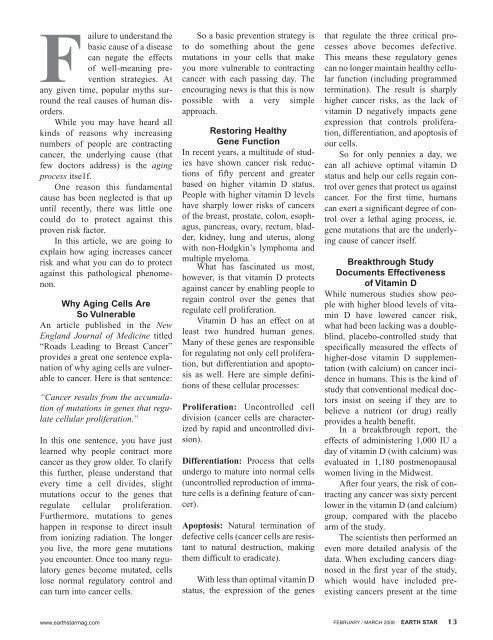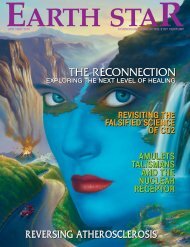GREGG BRADEN GREGG BRADEN - Earthstar
GREGG BRADEN GREGG BRADEN - Earthstar
GREGG BRADEN GREGG BRADEN - Earthstar
- No tags were found...
Create successful ePaper yourself
Turn your PDF publications into a flip-book with our unique Google optimized e-Paper software.
Failure to understand thebasic cause of a diseasecan negate the effectsof well-meaning preventionstrategies. Atany given time, popular myths surroundthe real causes of human disorders.While you may have heard allkinds of reasons why increasingnumbers of people are contractingcancer, the underlying cause (thatfew doctors address) is the agingprocess itse1f.One reason this fundamentalcause has been neglected is that upuntil recently, there was little onecould do to protect against thisproven risk factor.In this article, we are going toexplain how aging increases cancerrisk and what you can do to protectagainst this pathological phenomenon.Why Aging Cells AreSo VulnerableAn article published in the NewEngland Journal of Medicine titled“Roads Leading to Breast Cancer”provides a great one sentence explanationof why aging cells are vulnerableto cancer. Here is that sentence:“Cancer results from the accumulationof mutations in genes that regulatecellular proliferation.”In this one sentence, you have justlearned why people contract morecancer as they grow older. To clarifythis further, please understand thatevery time a cell divides, slightmutations occur to the genes thatregulate cellular proliferation.Furthermore, mutations to geneshappen in response to direct insultfrom ionizing radiation. The longeryou live, the more gene mutationsyou encounter. Once too many regulatorygenes become mutated, cellslose normal regulatory control andcan turn into cancer cells.So a basic prevention strategy isto do something about the genemutations in your cells that makeyou more vulnerable to contractingcancer with each passing day. Theencouraging news is that this is nowpossible with a very simpleapproach.Restoring HealthyGene FunctionIn recent years, a multitude of studieshave shown cancer risk reductionsof fifty percent and greaterbased on higher vitamin D status.People with higher vitamin D levelshave sharply lower risks of cancersof the breast, prostate, colon, esophagus,pancreas, ovary, rectum, bladder,kidney, lung and uterus, alongwith non-Hodgkin’s lymphoma andmultiple myeloma.What has fascinated us most,however, is that vitamin D protectsagainst cancer by enabling people toregain control over the genes thatregulate cell proliferation.Vitamin D has an effect on atleast two hundred human genes.Many of these genes are responsiblefor regulating not only cell proliferation,but differentiation and apoptosisas well. Here are simple definitionsof these cellular processes:Proliferation: Uncontrolled celldivision (cancer cells are characterizedby rapid and uncontrolled division).Differentiation: Process that cellsundergo to mature into normal cells(uncontrolled reproduction of immaturecells is a defining feature of cancer).Apoptosis: Natural termination ofdefective cells (cancer cells are resistantto natural destruction, makingthem difficult to eradicate).With less than optimal vitamin Dstatus, the expression of the genesthat regulate the three critical processesabove becomes defective.This means these regulatory genescan no longer maintain healthy cellularfunction (including programmedtermination). The result is sharplyhigher cancer risks, as the lack ofvitamin D negatively impacts geneexpression that controls proliferation,differentiation, and apoptosis ofour cells.So for only pennies a day, wecan all achieve optimal vitamin Dstatus and help our cells regain controlover genes that protect us againstcancer. For the first time, humanscan exert a significant degree of controlover a lethal aging process, ie.gene mutations that are the underlyingcause of cancer itself.Breakthrough StudyDocuments Effectivenessof Vitamin DWhile numerous studies show peoplewith higher blood levels of vitaminD have lowered cancer risk,what had been lacking was a doubleblind,placebo-controlled study thatspecifically measured the effects ofhigher-dose vitamin D supplementation(with calcium) on cancer incidencein humans. This is the kind ofstudy that conventional medical doctorsinsist on seeing if they are tobelieve a nutrient (or drug) reallyprovides a health benefit.In a breakthrough report, theeffects of administering 1,000 IU aday of vitamin D (with calcium) wasevaluated in 1,180 postmenopausalwomen living in the Midwest.After four years, the risk of contractingany cancer was sixty percentlower in the vitamin D (and calcium)group, compared with the placeboarm of the study.The scientists then performed aneven more detailed analysis of thedata. When excluding cancers diagnosedin the first year of the study,which would have included preexistingcancers present at the timewww.earthstarmag.com FEBRUARY / MARCH 2008 EARTH STAR 13
















